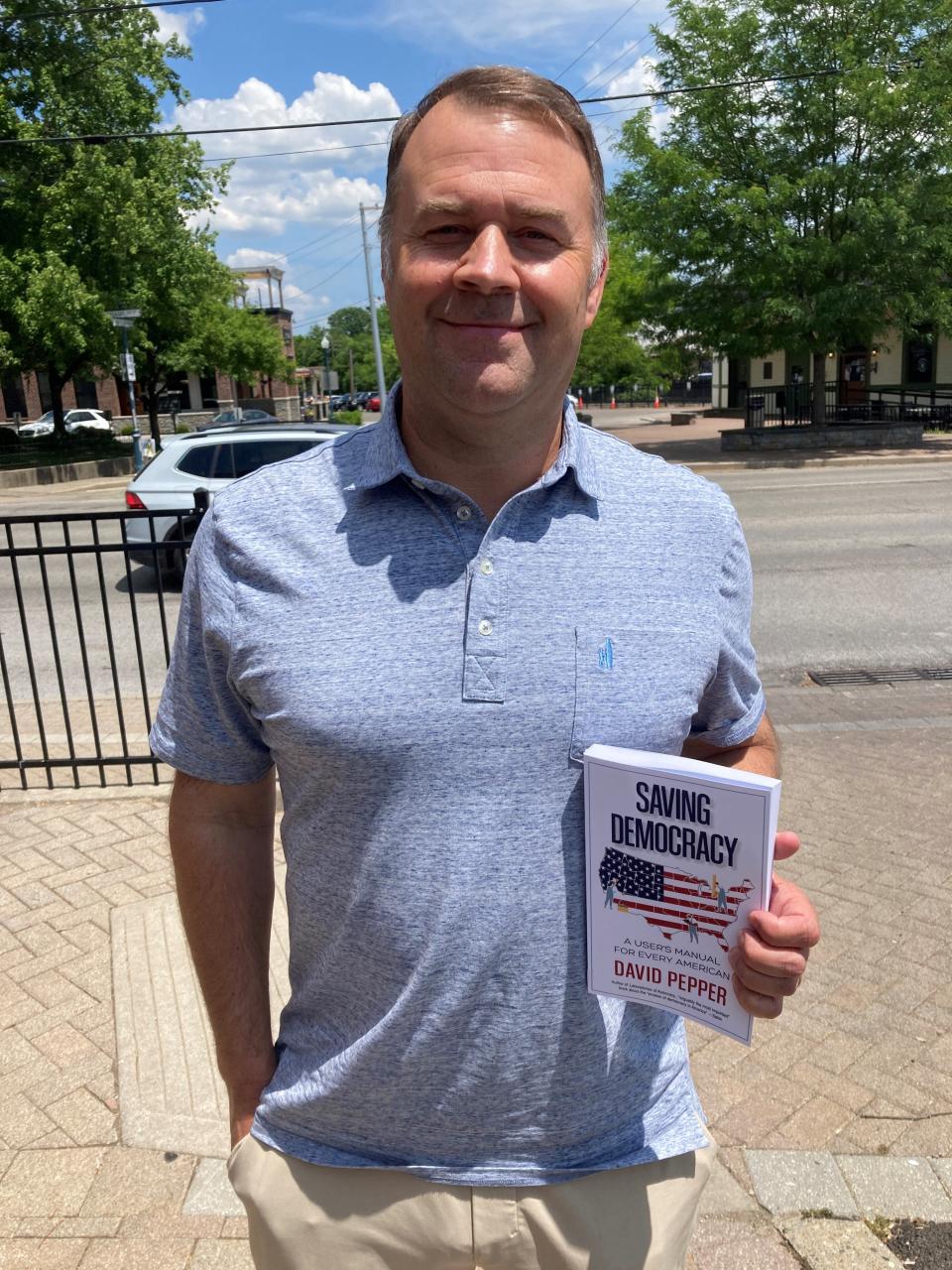Cincinnati City Council field of candidates is the smallest in 3 decades. Why?

- Oops!Something went wrong.Please try again later.
If you like the current Cincinnati City Council, you're in luck. They'll mostly − or all − be back after this election.
No, the Enquirer doesn't have a crystal ball that can predict the future. It's just that only 10 people are running for nine seats − the smallest field of candidates in at least three decades.
Audricia Brooks, a political newbie from North Avondale, didn't make the ballot after all. The Hamilton County Board of Elections made a mistake in verifying her signatures, which meant in the end she didn't have the needed 500 signatures.
But why are so few people running? A combination of the muscle of the powerful Democratic Party-endorsed slate set months ago; disillusion with city government that has been the target of a sweeping FBI corruption investigation; the polarized national political climate; and, as one longtime candidate put it, the "bullying" of anyone perceived as an outsider has made running without the Democratic endorsement nearly impossible.
In all, 30 people picked up petition packets. Only 13 turned in signatures, including the nine people who hold council seats now. Of those nine, eight are Democrats, one a Republican. Two, including Brooks, didn't have the needed valid signatures and another candidate withdrew from the race.
The only non-incumbent candidate is Anna Albi, a Madisonville anti-gun violence activist who nabbed a Cincinnati Democratic Committee endorsement.
Consider: In the 2021 council race, 35 people ran − the most in 32 years, according to data on the Hamilton County Board of Elections website, which has council race data dating back to 1991. In that 32-year stretch of time, the fewest number of candidates was 18, the field in both 1995 and 1997.
The council runs Ohio's third-largest city, which has a combined budget of more than a billion dollars and a trove of issues that include poverty, youth violence and fiscal woes.
There are nine council seats, with candidates running in a field race where the top nine vote-getters are elected. Council members are paid $60,000. Cincinnati has leaned blue, but voters in the past voted in at least two Republicans, which provided gave some check and balance. The only Republican council member is Liz Keating and she is the lone Republican running.
Council terms currently last two years after a brief period − 2013 to 2021 − when terms lasted four years.
'You dissuade good people from running'
Last year, it seemed like the 2023 council race would be crowded. When then-Councilman Greg Landsman left City Council early for a seat in the U.S. House of Representatives, 37 people applied to be appointed to his seat. Councilman Reggie Harris, who made the appointment, was clear that people who applied should be willing to run this year. The hopeful appointees said they would.
Councilman Seth Walsh got the job. He's running, but none of the others who applied has so far filed to run.
Jaime Castle, a teacher from Mount Washington, gathered the needed 500 signatures to run but withdrew when she missed out on the Democrat endorsement.
On Facebook, she wrote, "I officially withdrew as it is the best thing for myself and my family given the timing and the circumstances. Dropping out is the best thing also for any future run success. I’ll be concentrating on my family, my new teaching job, my youth soccer coaching, and my leadership roles at my church and for my community council here in Mt. Washington."
Michelle Dillingham, a longtime Democratic operative who works with teachers and missed nabbing a seat by 223 votes in 2017, isn't even trying this year.
She had a lot to say.
"A lot of party insiders already decided before people even showed up," Dillingham said. "That is not good party building. You dissuade good people from running."
The fallout goes beyond one race, Dillingham said. "You're not building a bench. We should have a lot of people running. Even if you don’t win, you learn."
Respected Democrat Roxanne Qualls didn't win during her first run. Landsman didn't either. On the Republican side, former U.S. Rep. Steve Chabot didn't win his first time on the ballot and U.S. Rep. Brad Wenstrup, R-Hillsboro, ran for mayor and lost before winning Ohio's 2nd Congressional District.
Dillingham said she understands there are only nine endorsements to dole out but added, "The way this party operates, it’s almost like you are bullied. If you don't get the endorsement, you are treated very badly. This is the result. The field is very small, and people are not willing to put themselves out on the campaign trail and get beat up."
Wide field of candidates offers 'food for thought'
David Pepper – a former Democrat on council, former Ohio Democratic Party chairman and author of "Laboratories of Autocracy: A Wake-up Call from Behind the Lines" – praised the party for organizing. But he said a diversity of ideas is lost in smaller fields of candidates.

"Democrats figured out running as a slate brings real value," Pepper said. "They have been very organized about getting the votes out and have been rewarded with good results.
"But," he said, "it probably makes others think they can’t win. Having been a candidate in fields of 25 and 30 candidates, there was a value-add to wide-open races. You want established candidates, but also the fiery speeches of the Nate Livingstons and Tom Brinkmans. It was food for thought. It was interesting. You lose something without that conversation."
Livingston was a vocal council critic and Brinkman was a conservative candidate who went on to become a state representative.
"Running is part of the democratic process," Pepper said.
"It’s really hard to get a start in politics, especially with gerrymandered districts," he added. "City Council is the best way to get a start."
'It starts to wear on the good-natured'
David Niven, a political science professor at the University of Cincinnati, called the candidate list "a short stack at the moment."
"The story is the level of success the Democratic Party has had in recent elections," Niven said. "How many seats are really available if you’re not on the inside? It starts to wear on the good-natured, wholesome, civic-minded candidates. The plausibility of an outsider winning is shrinking and shrinking."
Niven said without being on the slate it's tough to make the case for yourself when voters don't know you. Cincinnati is a city of more than 300,000 people and 52 neighborhoods.
"Where else do you hand voters a ballot say, 'You figure it out?'" Niven said.
What's happening in Cincinnati happened in Columbus in recent decades, Niven said. Democrats dominate Columbus City Council.
"The endorsement meeting becomes more and more valuable, more and more contentious and then it becomes the election itself," he said.
Liz Keating is the lone Republican in the race

Hamilton County Republican Chairman Russell Mock called Keating his "lone horse."
Mock is new to the job and tried to find Republicans to run but was continually told no. As Hamilton County and the city itself become bluer, it would be difficult for any Republican candidate, but losing can be a stepping stone to other political posts.
Wenstrup got his political start with an unsuccessful Cincinnati mayoral run in 2009.
Mock's takeaway: "The political environment is making people turn away. Some of the complete absurdity on both sides leads to people not wanting to participate in the process. And it's not just Republicans, there aren't as many Democrats either."
People don't want to talk about politics, let alone put themselves in the public eye, Mock said.
"It leads to an argument one way or the other," Mock said. "So people put their heads in the sand and hope it gets better."
He added: "It's not the solution, but it is what is happening."
This article originally appeared on Cincinnati Enquirer: Few have filed to run for Cincinnati Council. Here's why

